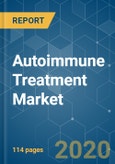The autoimmune treatment market is expected to grow with a CAGR of 4.2%, over the forecast period. The major factor attributing to the growth of the autoimmune treatment market is surge in prevalence of autoimmune diseases. According to NIH (National Institutes of Health) up to 23.5 million Americans have an autoimmune disease and the prevalance is increasing. Scientists have identified 80-100 various autoimmune diseases and assume at least 40 other diseases of having an autoimmune basis. The other factors that play a major role in taking the autoimmune treatment market to the next level are increasing investments in research and development of drugs for autoimmune diseases, technological advancements in diagnosis and awareness of the therapy. Rising government initiatives for regulating these diseases is also helping the growth of the market. However, higher costs of the therapeutics and low medical insurance coverage are constraining the market growth.
Key Market Trends
Rheumatic Disease segment is Expected to Hold Large Market Share
North America Dominates the Market and Expected to do same in the Forecast Period
North America is expected to dominate the overall autoimmune treatment market, throughout the forecast period. This is due to factors such as the rising incidence and prevalence of autoimmune diseases like arthritis, lupus, multiple sclerosis, in the country. In the North America region, the United States holds the largest market share due to growing personal expenditure on healthcare. The healthcare commerce in the province is developing at a quick stride, resulting in the progress of the North America Autoimmune treatment market. Furthermore, beneficial government initiatives and an increase in the number of research partnerships are some of the drivers expected to increase market growth.
Competitive Landscape
The autoimmune treatment market is moderately competitive and consists of several major players. In terms of market share, few of the major players are currently dominating the market. Some of the companies which are currently dominating the market are AbbVie, Amgen, Johnson & Johnson, Eli Lilly & Co., Pfizer, F. Hoffmann-La Roche AG, Astrazeneca Plc and Bristol-Myers Squibb Co.
Reasons to Purchase this report:
This product will be delivered within 2 business days.
Key Market Trends
Rheumatic Disease segment is Expected to Hold Large Market Share
- The rheumatic disease segment is expected to dominate the market owing to the rising cases of diseases. Rheumatic diseases are described by swelling that affects the connecting structures of the body, mostly the joints, sometimes the tendons, ligaments, bones, and muscles.
- The therapeutics for rheumatoid disease holds the significant share and expected to remain assertive during the forecast period, due to the rising geriatric population, increasing number of pipeline drugs and the increasing cases of arthritis, fibromyalgia, systemic lupus erythematosus, gout and others, and varied range and availability of progressive therapeutics for the treatment of these diseases.
- In 2018, according to RheumatoidArthritis.org, around 1.3 million Americans were affected by Rheumatoid arthritis, and the number is increasing every year, which is a driving factor for the autoimmune treatment market.
North America Dominates the Market and Expected to do same in the Forecast Period
North America is expected to dominate the overall autoimmune treatment market, throughout the forecast period. This is due to factors such as the rising incidence and prevalence of autoimmune diseases like arthritis, lupus, multiple sclerosis, in the country. In the North America region, the United States holds the largest market share due to growing personal expenditure on healthcare. The healthcare commerce in the province is developing at a quick stride, resulting in the progress of the North America Autoimmune treatment market. Furthermore, beneficial government initiatives and an increase in the number of research partnerships are some of the drivers expected to increase market growth.
Competitive Landscape
The autoimmune treatment market is moderately competitive and consists of several major players. In terms of market share, few of the major players are currently dominating the market. Some of the companies which are currently dominating the market are AbbVie, Amgen, Johnson & Johnson, Eli Lilly & Co., Pfizer, F. Hoffmann-La Roche AG, Astrazeneca Plc and Bristol-Myers Squibb Co.
Reasons to Purchase this report:
- The market estimate (ME) sheet in Excel format
- 3 months of analyst support
This product will be delivered within 2 business days.
Table of Contents
1 INTRODUCTION
4 MARKET DYNAMICS
5 MARKET SEGMENTATION
6 COMPETITIVE LANDSCAPE
Companies Mentioned (Partial List)
A selection of companies mentioned in this report includes, but is not limited to:
- Abbvie
- Amgen Inc.
- Johnson & Johnson
- Eli Lilly and Company
- Pfizer Inc.
- F. Hoffmann-La Roche AG
- Astrazeneca Plc
- Bristol-Myers Squibb Co.
- Lupin Limited
- GlaxoSmithKline Plc
Methodology

LOADING...







